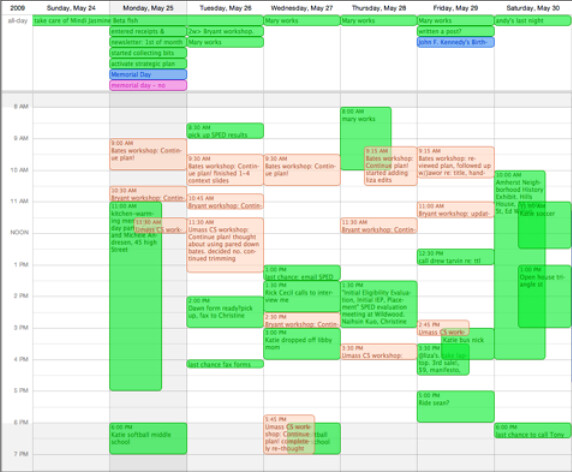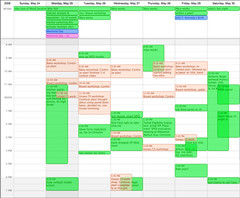Testing the classics: A Time Management Experiment: Time Blocking
 Tuesday, June 2, 2009 at 9:45AM
Tuesday, June 2, 2009 at 9:45AM Nothing beats project anxiety like a plan. -- me :-)
You know me - I love experimenting on myself almost as much as on you. Or my clients. Kidding aside, I've studied many, many techniques to manage ourselves as we work, and a classic on is time blocking, AKA time mapping (see [1] for more). It's a simple idea: Schedule regular chunks of time with yourself for important tasks. The experiment I've tried for the last few weeks is applying it to three largish projects coming up (higher education workshops) with a relatively short timeline (less than a month). The advantage is it forced me to make steady progress on projects to prevent last minute scrambling, stress, and failure. The result: Worked great!
Following are the details, along with a few rules and caveats when time blocking.
(Updated 2009-06-08 to remove confusing project plan image.)
Planning and estimating
My first step was to get my head around all the work I'd committed to. The three workshop projects ranged in complexity from updating an existing full-day one, through adapting one for a shorter program, to creating a brand-new 90 minute one from scratch. I applied the planning ideas I'm developing (see Simple Project Planning For Individuals: A Round-up) and came up with the number of hours needed per project: 8, 12, and 18 hours, respectively. I tried to be conservative in my estimates, but ultimately only time would tell (uncertainty is a function of experience).
I then calculated the number of days available for each project from the day I started: 15, 24, and 19 workdays, respectively. Thus, to stay sane and on-target I needed to spend the following time every day for the next four weeks: 1/2 hour/day, 1/2 hour/day, and 1 hour/day. In other words, because of my (happily) agreeing to take on the jobs, I'd committed to working on these three projects 2 hours EVERY DAY. That was a shock.
Implementing
The next step was to simply create repeating entries in my calendar for the three blocks. Here's a screenshot from iCal for a typical week. (Note: Not all client work is shown in this view.) What you should focus on is the orange chunks.

You'll notice a couple of things. First, while they were all initially scheduled for the same time each day (in the morning - my prime time), you see that they've been moved. This was the first thing I learned - my life is unpredictable and varying enough that planned times don't always meet reality. So I adapted by negotiating with myself and pushing them down. I'm sure you see the possible problem: Pushing them completely off the bottom, i.e., not getting some done. I found I was consistently able to honor my commitment to myself (a zero tolerance rule), but this meant working late some nights - part of the deal of being a self-employed parent.
One novel thing I did that was helpful was using each block as a project accountability record. I did this by simply editing each appointment after finishing it by adding a short description of what I got done. This kept me honest. This little record-keeping didn't replace my full project plan. Like all my projects, that was captured and tracked in each project's outline.
Finally, if when I was deep in the flow I extended the time beyond what I'd allotted. The rule, though, was no borrowing from the others! This information was useful in after-action project analyses, esp. in answering, "How did estimated and actual compare?"
Wrap-up, Questions, and Challenge
Though I've tried smaller versions of this, overall the experiment validated this approach, and I'll continue recommending it to clients.
I'm curious: Have you (or do you) used this for yourself? For what projects does it work best? What have you learned that you'd like to share?
If you haven't yet tried time blocking, I'd like to challenge you to give it a spin on your next new project. Call or email me if you'd like help. I'd love to hear how it goes. Cheers!
References
- [1] See Time Design ("consistently setting aside time for high priority activities") or Julie Morgenstern ("allotting specific spaces in your schedule for tending to the various core activities of your life").



